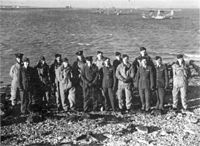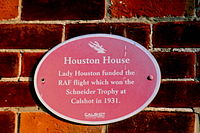RAF Calshot
After the war, Calshot continued its crew training and aircraft development role, and became home to the RAF School of Naval Co-operation and Aerial Navigation.The flight was beset by bad weather and several mishaps, including a crash in Akyab Harbour, Burma (requiring a replacement aircraft); and eventually a forced sea landing near Bering Island ended the attempt.While there he was seconded to the nearby British Power Boat Company factory, where he worked with Hubert Scott-Paine in the development of the 200 Class Seaplane Tender, at the time claimed to be the fastest craft of their size in the world.[9] Also in 1940, a small number of ex Norwegian Heinkel He 115 flying boats arrived – later to be used for covert operations, landing and collecting agents from occupied Europe.In February 1950, whilst ferrying crew to their Sunderland flying boat as Duty Coxswain, an aircraft he had earlier supplied with technicians, burst into flames.Two unfinished Saunders-Roe Princess flying boats, designed to carry 100 passengers and with a range of 5000 miles, were cocooned at RAF Calshot, near the island hangar during the 1950s and 1960s, before being scrapped.[14] On 25 July 1970, the RNLI sent the Keith Nelson type lifeboat ON 1017 Ernest William and Elizabeth Ellen Hyde to Calshot for evaluation, and in 1971 a permanent station was established.






CalshotHampshireRoyal Air Force stationMinistry of DefenceRoyal Air ForceFirst World WarSecond World Warseaplaneflying boatCalshot SpitSouthampton WaterEnglandgrid referenceIsle of WightSolentSaunders-RoeCalshot Activities CentreRoyal Flying CorpsCalshot Naval Air StationRoyal Naval Air ServiceFelixstoweNo. 10 Group RAFreconnaissanceVickers VultureBering IslandHigh Speed FlightSchneider TrophyVeniceSupermarine S.5Supermarine S.6BT. E. LawrenceBritish Power Boat CompanyHubert Scott-Paine201 SqnSupermarine SouthamptonSaro Londons240 SqnSupermarine ScapasShort SingaporesvelodromeWorld War IIPembroke DockInvergordonStranraerShort Sunderlandsevacuation at DunkirkNorwegianHeinkel He 115No 230 SquadronBerlin crisis of 1948BerlinHamburgGeorge MedalDuke of GloucesterGeorge VISaunders-Roe PrincessRAF Mount BattenPlymouth SoundHampshire County CouncilCrown EstatesKeith Nelson type lifeboatstationTyne-classShort SandringhamSolent SkySouthamptonFloridaKermit WeeksFantasy of FlightHM Coastguardhangarsartificial ski slopescycle trackSeaplane bases in the United KingdomAirfields of Britain Conservation TrustShrewsburyCommandsGroupsSquadronsFlightsConversion unitsOperational Training unitsSchools / Training unitsFerry unitsGlider unitsMisc unitsActiveFormerSatellite Landing GroundsAir Force BoardRAF RegimentRAF Chaplains BranchRAF IntelligenceRAF Legal BranchRAF Medical ServicesPrincess Mary's RAF Nursing ServiceRAF PoliceRAF ground tradesRAF Music ServicesRAF Search and Rescue ForceRAF Mountain Rescue ServiceRAF Marine BranchRAF Air CadetsOperationsRoyal Auxiliary Air ForceRAF Volunteer ReserveList of RAF aircraftcurrentfutureList of RAF missilesList of equipment of the RAF RegimentOfficer ranksOther ranksList of notable personnelList of serving senior officersPersonnel numbersChief of Air StaffAssistant Chief of the Air StaffAir Member for PersonnelAir SecretaryAir Member for MaterielCommandant-General of the RAF RegimentWarrant Officer of the RAFEnsignRoundelsUniform